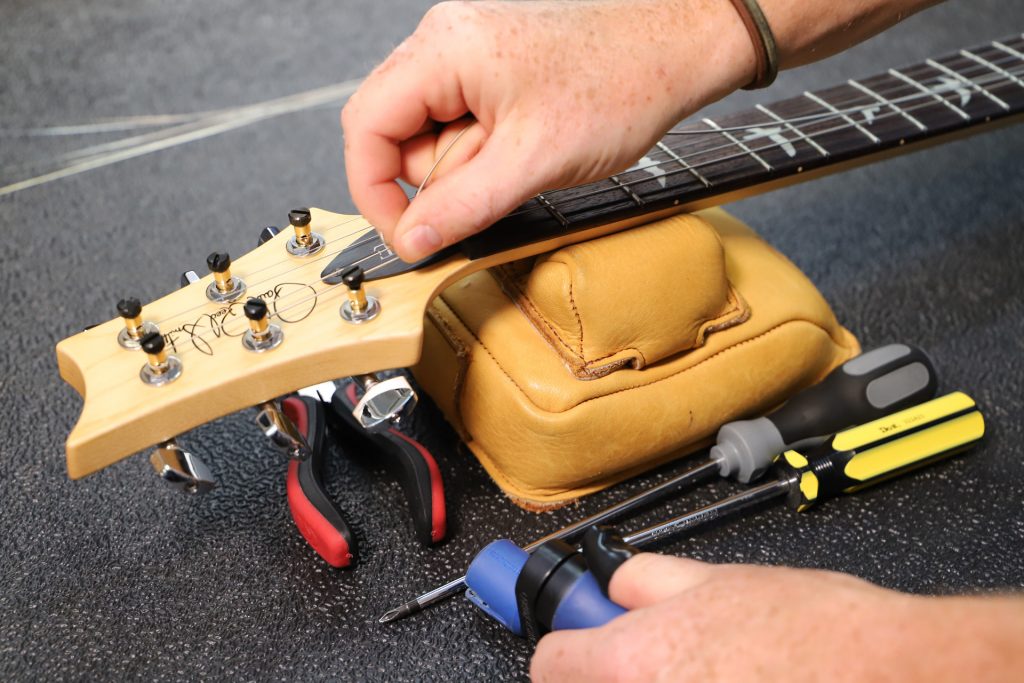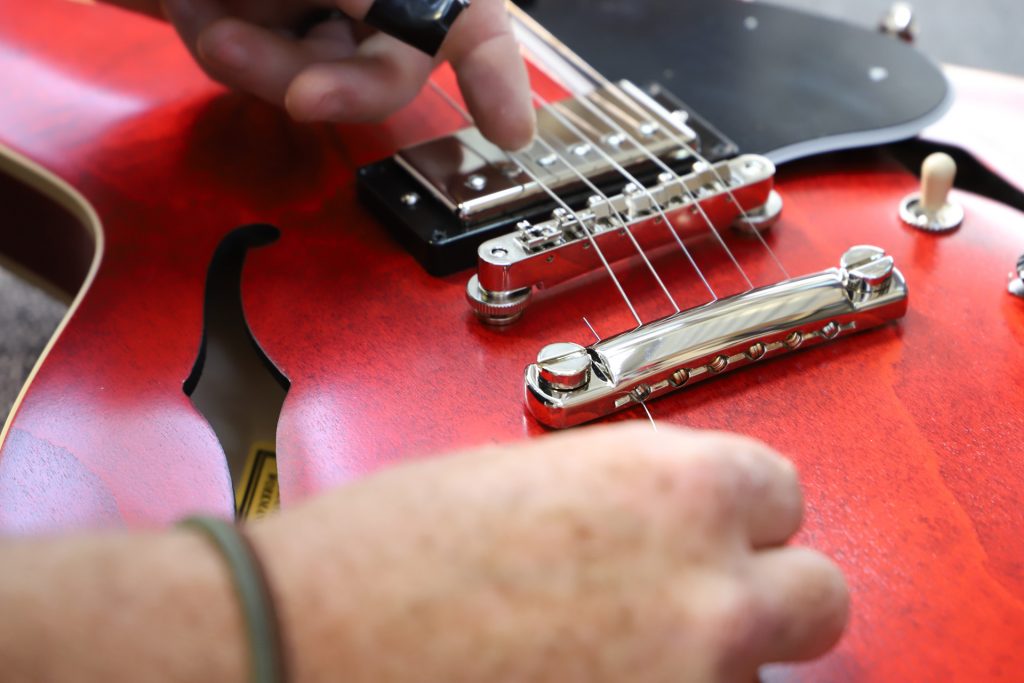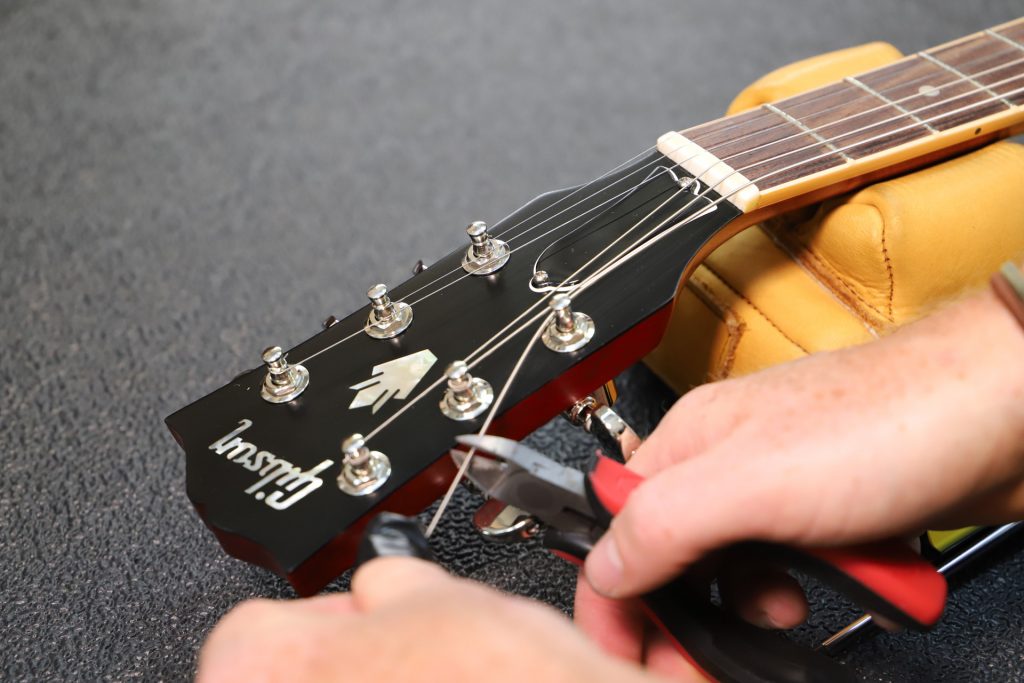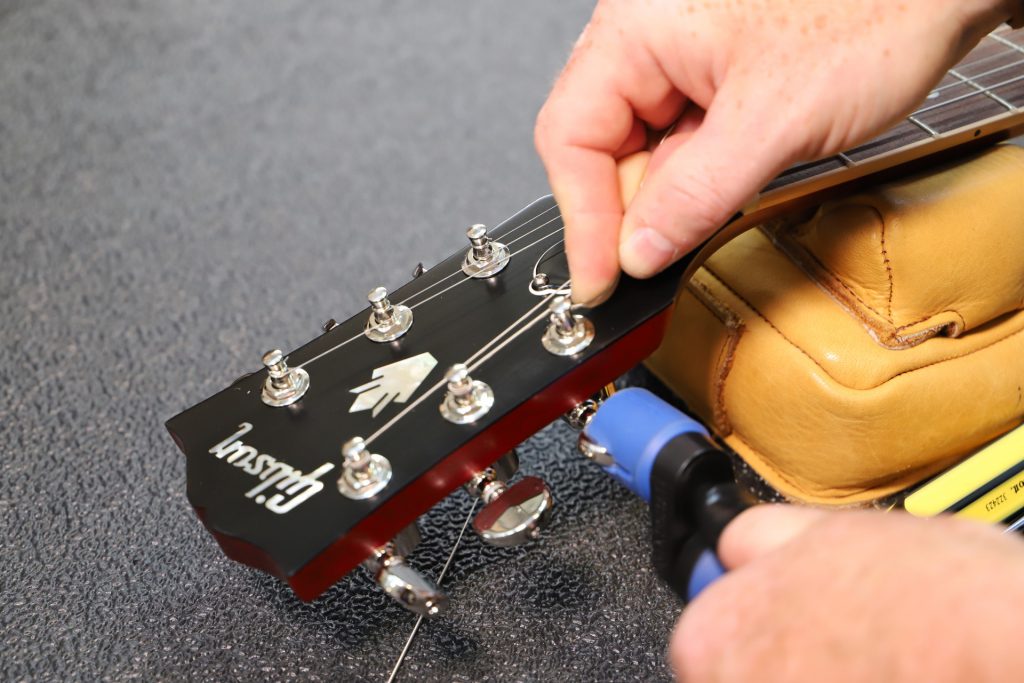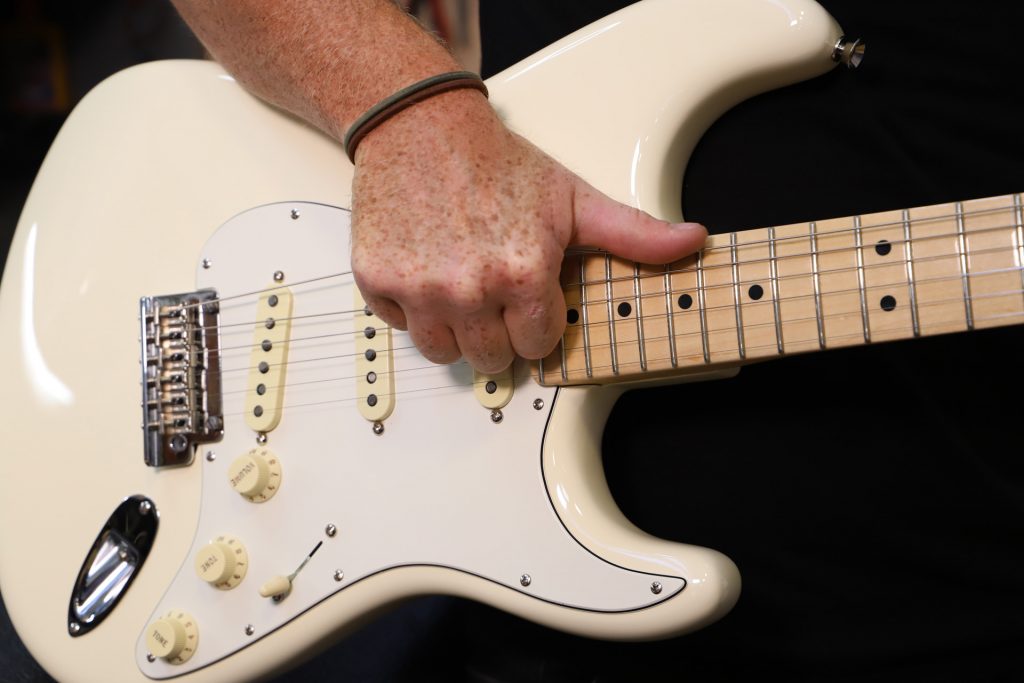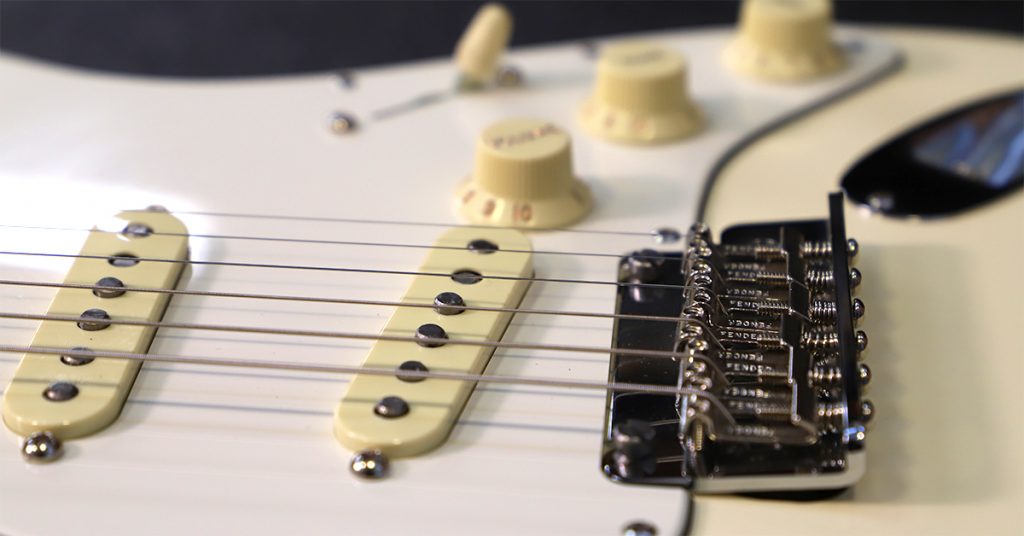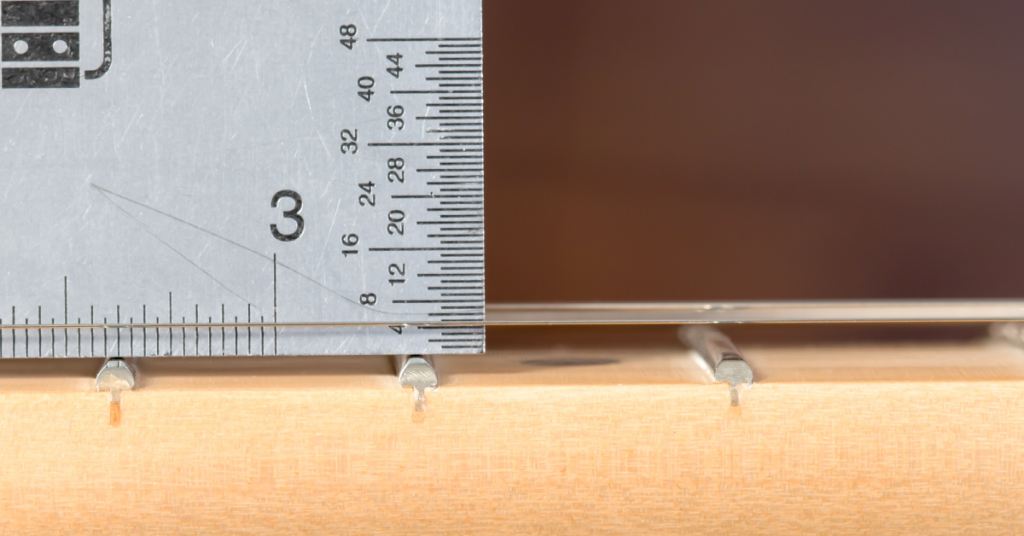How to Restring an Electric Guitar
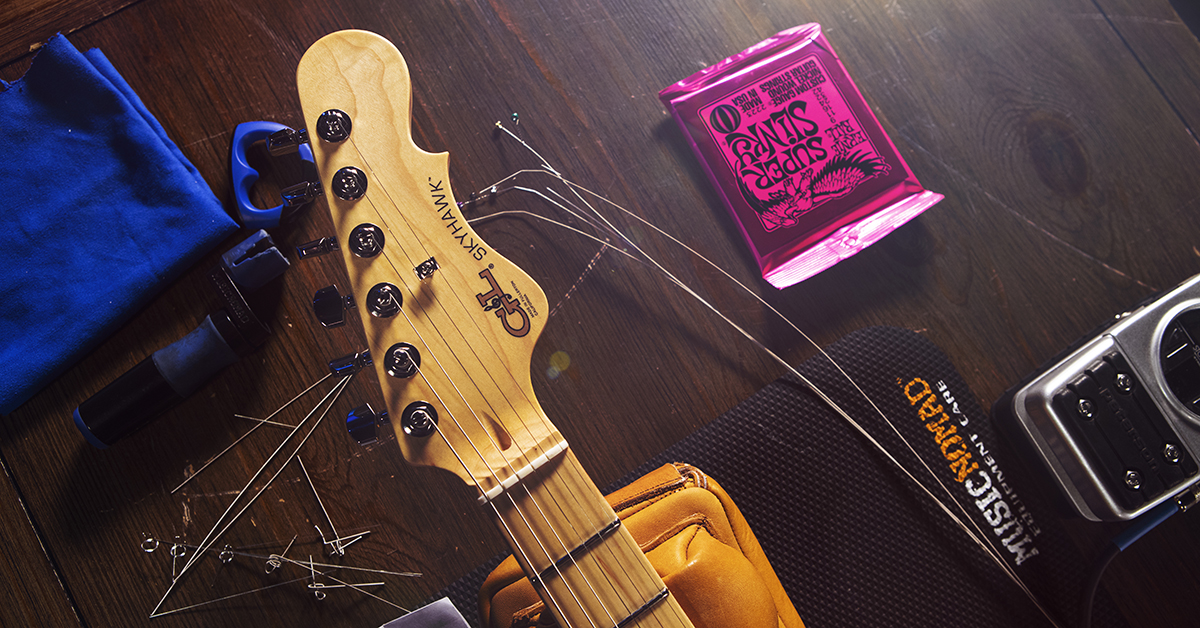
How to Change Electric Guitar Strings
In this guide, we will show you how to change the strings on your electric guitar. You will learn how to safely remove the old strings and install a new set. Follow each of the sections below to get started.
- How to String an Electric Guitar
- How Often Should You Change Strings?
- Set Up Your Electric Guitar After Changing Strings
- Related Content
How to String an Electric Guitar
Changing a guitar’s strings, or restringing it, means to replace the current set of strings with a new set. In the sections below, we’ll explain the three phases of restringing:
Change strings one at a time or all at once?
It depends!Changing one string at a time prevents the tension from drastically changing across the whole guitar. That’s ideal for minimizing the time it takes for tension to adjust. It’s also the only option when you just have to replace a single broken string. Removing all the strings at once gives you the perfect opportunity to clean your guitar’s fretboard (recommended cleaning products only!).
Conclusion: It depends, and it isn’t that big of a deal. One at a time will maintain string tension across the guitar and reduce the time it takes to stabilize; but if you need to clean the fingerboard, it makes more sense to remove all the strings at once.
String-changing tools
There are many useful cutting and winding tools available that make string changing fast and easy.
While some tools on the market are strictly for changing strings, others are multi-tools that can do more than just string changes. Nonetheless, the only tool potentially required to restring a guitar is a wire cutter for cutting off excess string after the tuning post.
Keep in mind that guitars often have different parts that affect the setup, or playability. You’ll want to consider which tools are required to adjust them, such as the hex key/Allen wrench often included with guitars.
1. Detune and remove old strings
To start changing strings, begin by removing the old strings. This is done by detuning each string until its completely loose and then cutting it in half. You don’t have to cut the strings, but it does make removing the strings easier. Old strings aren’t typically reused but can be repurposed or recycled.
- Detune the string until it has no tension and no longer produces a pitch.
- Use wire cutters to cut the string in half, usually where the neck meets the body.
- Remove the old strings from the tuning posts and bridge entry.
- Repeat for each string.
- If changing one string at a time, continue to Install new strings.
Clean the fretboard
Removing all the strings at once is the best time to clean your guitar’s fretboard and frets. Use a soft cloth and recommended cleaner to remove any built-up debris. Unfinished fretboards (rosewood, ebony, etc.) require a compatible (oil-based) wood conditioner, while finished fingerboards only need a simple polish.
2. Install new strings
Now that the old strings are off, let’s put the new ones on. The most important thing to remember when installing new strings is not to overtighten them too much. That’s because the strings need to stretch and adjust to the new tension. Just be cautious that if tuned up too high (above standard tuning), the strings could snap under the tension. To prevent breaking new strings, change each string one at a time, paying attention to which one you’re replacing and which tuning key adjusts it.
Installing strings has three sub-steps:
- 2.1 Identify and insert each string
- 2.2 Crimp and trim the non-ball end
- 2.3 Tighten string and wind around tuning post
2.1 Identify and insert each string
- Remove the strings from their packaging. Identify each string either by the packaging label or by the color of its ball end.
- Unwind and insert the string through its corresponding bridge entry. Carefully pull it all the way through, using your fingers to help prevent it from grinding against the bridge hole.
- Align the string over both its bridge saddle and nut slot.
- Continue to Crimp and trim the non-ball end >
2.2 Crimp and trim the non-ball end
- Leaving no slack before the bridge/tailpiece, guide the string to the center of its corresponding tuning post.
- Move the string to the tuning post, either through or into depending on the tuner style:
- Through the post: Measure an additional 1–2 inches of string from the tuning post and trim it off with the wire cutters.
- Into the post (headstock): Measure an additional 1–2 inches from where the string crosses the tuning post and then bend (a.k.a. crimp) the string at a 90-degree angle. Measure an additional half inch to an inch of string beyond the crimp and trim it off with the wire cutters.
- Continue to Tighten string and wind around tuning post >
2.3 Tighten string and wind around tuning post
- Remove any twists that may have developed while installing the string.
- Tighten the string by turning the tuning key, making sure the string wraps downward along the post. Keep turning the key and, as the ball end approaches the bridge/tailpiece, orient the string so that it is untwisted and secure against the correct bridge saddle and nut slot.
- Continue to turn the key until the ball end is secure against the bridge/tailpiece.
- Tune the string to pitch and then trim off any excess string.
3. Stretch and tune
Once restrung, you’ll notice that the strings will keep going out of tune until they’ve “settled” or been “broken in.” That’s because they need to adapt to the new tension. One way to decrease the time it takes for the strings to adapt is by stretching them. Perform a stretching motion along the entire length of the string to acclimate it quicker and stabilize the pitch. Tune, stretch, repeat.
How Often Should You Change Electric Guitar Strings?
How often guitar strings need to be changed is kind of open to interpretation; but, ultimately, it depends on the sounds you want to create and how often you play that guitar. If you simply want to make your strings last longer before needing to restring, then consider always wiping down your strings and using a fretboard-safe string cleaner.
- A studio guitar that is only ever played softly with a pick could last a few sessions before needing to be restrung. At the same time, moisture and oils from your hands could compromise that “brand-new” feel and tone even after playing a few times.
- Touring guitarists might change their strings more frequently, even on a daily basis. This is so that the feel and sound remain consistent for each performance.
How Long Do Guitar Strings Last?
Do those who require a new set of strings for each performance really need them? And what about the select few who never change their strings?
Cleaning dirty strings
The most common reason for changing strings is because they’ve become dirty, lost their tone, and/or don’t stay in tune anymore. When your fingers, palms, and arm touch the guitar, they’ll transfer sweat, oil, and dead skin cells (yuck!). All that gunk gets caught between the string windings and alters both the sound and feel. If not wiped off after playing, then it will build up, reduce sustain, and ultimately dull the sound quality. Learn more about how to clean guitar strings.
Cleaning guitar strings is useful when you want to maintain a clear tone without installing a new set of strings.
Change guitar string gauges or sizes
Aside from the routine wear and tear, you may also want to change strings to adjust your playing style. Every different set of strings varies in tension, tone, and feel, so there are many nuances to consider when selecting another set. Changing the gauge (string diameter) will change the tension (playability) but also will require a setup to accommodate the new string size. Changing the material (nickel, stainless steel, nylon, etc.) will change the frequency content (bright vs. warm)and sustain. Not sure which to get? Just choose a set that has specifications ideal for your favorite genre or personal playing style. Learn more about how to choose electric guitar strings.
How to Choose Electric Guitar Strings
Deciding between string gauges, materials, and brands can be a bit much. Follow these tips to help find the best guitar strings for your electric guitar!
Set Up Your Electric Guitar After Changing Strings
Electric guitars need to be “set up” to accommodate the changes in string size. That means, when you change strings, you usually need to adjust the guitar, too. The diameter (gauge) determines the string tension, which affects the truss rod (neck bow), action (string height), and intonation (string length). If you’re restringing with an identical set of strings, then you shouldn’t have to adjust much; but it never hurts to double-check.
How To Set Up Your Electric Guitar
In this three-part series, we’ll discuss everything you’ll need to know to start doing professional-grade setups at home.
Related Content
- How to Restring a Bass Guitar
- How to Restring a Floyd Rose
- Guitar Care and Maintenance Guide
- Guitar Pedal Effects Troubleshooting Guide
- Understanding Acoustic Guitar Humidity
Related videos
- Fender: How to Change Your Electric Guitar Strings
- Gibson: How to Change Guitar Strings and Tune an Electric Guitar
- Dunlop: Restring a Les Paul-style Guitar
- Dunlop: Restring a Fender-style Guitar
- Dunlop: Restring a Bass Guitar
- Dunlop: Changing String Gauges
- StewMac: How to String an Electric Guitar
When you need help, Sweetwater has the answers!
Our knowledge base contains over 28,000 expertly written tech articles that will give you answers and help you get the most out of your gear. Our pro musicians and gear experts update content daily to keep you informed and on your way. Best of all, it’s totally FREE, and it’s just another reason that you get more at Sweetwater.com.


